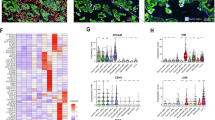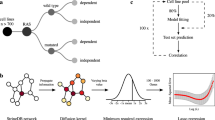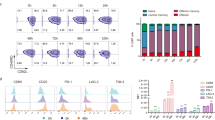Abstract
In mouse epidermal carcinogenesis, the latest stage of malignant progression involves the transition from squamous cell carcinoma to a highly aggressive type of tumor with spindle morphology. In this work, we have isolated a minor epithelial cell subpopulation (CarC-R) contained in the highly malignant spindle carcinoma cell line CarC. CarC-R exhibited a drastic reduction in tumorigenicity when compared with CarC, but CarC-R-induced tumors were mainly sarcomatoid, although they subsequently reverted to the epithelial phenotype when tumor explants were recultured in vitro. Several single-cell clones with either stable epithelial or fibroblastic phenotypes were isolated from an explanted CarC-R tumor (CarC-RT). All these cell lines contained the same specific point mutation in H-Ras codon 61, but while CarC spindle cells had lost the normal H-Ras allele, it was retained in CarC-R- and CarC-RT-derived cell lines. Furthermore, CarC cells have inactivated p16INK4a and p19INK4a/ARF transcription, while CarC-R and CarC-RT clones expressed p19 mRNA and protein but not p16. Altogether, these results suggest that CarC-R represents a precursor stage to CarC in malignant progression. Spectral karyotyping analysis revealed that CarC-R was highly aneuploid and contained many chromosomal abnormalities. In contrast, CarC had a diploid or tetraploid modal chromosome number and contained a specific T(14;15) translocation in all of the analysed metaphases. The T(14;15) translocation was present in only a minority (1.9%) of CarC-R cells, but it was widely spread in CarC-RT and its derived cell clones, regardless of their epithelial or fibroblastic phenotype, indicating that T(14;15) segregates with malignancy.
This is a preview of subscription content, access via your institution
Access options
Subscribe to this journal
Receive 50 print issues and online access
$259.00 per year
only $5.18 per issue
Buy this article
- Purchase on SpringerLink
- Instant access to full article PDF
Prices may be subject to local taxes which are calculated during checkout






Similar content being viewed by others
References
Akhurst RJ and Balmain A . (1999). J. Pathol., 187, 82–90.
Aldaz CM, Conti CJ, Klein-Szanto AJ and Slaga TJ . (1987). Proc. Natl. Acad. Sci. USA, 84, 2029–2032.
Aldaz CM, Trono D, Larcher F, Slaga TJ and Conti CJ . (1989). Mol. Carcinogen., 2, 22–26.
Beheshti B, Park PC, Sweet JM, Trachtenberg J, Jewett MA and Squire JA . (2001). Neoplasia, 3, 62–69.
Bella JL, Fernandez JL and Gosalvez J . (1995). Genome, 38, 864–868.
Bianchi AB, Aldaz CM and Conti CJ . (1990). Proc. Natl. Acad. Sci. USA, 87, 6902–6906.
Bremner R and Balmain A . (1990). Cell, 61, 407–417.
Buchmann A, Ruggeri B, Klein-Szanto AJ and Balmain A . (1991). Cancer Res., 51, 4097–4101.
Burns PA, Kemp CJ, Gannon JV, Lane DP, Bremner R and Balmain A . (1991). Oncogene, 6, 2363–2369.
Celeste A, Difilippantonio S, Difilippantonio MJ, Fernandez-Capetillo O, Pilch DR, Sedelnikova OA, Eckhaus M, Ried T, Bonner WM and Nussenzweig A . (2003). Cell, 114, 371–383.
Conti CJ, Aldaz CM, O’Connell J, Klein-Szanto AJ and Slaga TJ . (1986). Carcinogenesis, 7, 1845–1848.
Diaz-Guerra M, Haddow S, Bauluz C, Jorcano JL, Cano A, Balmain A and Quintanilla M . (1992). Cancer Res., 52, 680–687.
Difilippantonio MJ, Petersen S, Chen HT, Johnson R, Jasin M, Kanaar R, Ried T and Nussenzweig A . (2002). J. Exp. Med., 196, 469–480.
Duesberg P, Rasnick D, Li R, Winters L, Rausch C and Hehlmann R . (1999). Anticancer Res., 19, 4887–4906.
Duesberg P, Rausch C, Rasnick D and Hehlmann R . (1998). Proc. Natl. Acad. Sci. USA, 95, 13692–13697.
Duro D, Bernard O, Della Valle V, Berger R and Larsen CJ . (1995). Oncogene, 11, 21–29.
Frame S and Balmain A . (2000). Curr. Opin. Genet. Dev., 10, 106–113.
Frame S, Crombie R, Liddell J, Stuart D, Linardopoulos S, Nagase H, Portella G, Brown K, Street A, Akhurst R and Balmain A . (1998). Philos. Trans. R. Soc. Lond. Ser. B, 353, 839–845.
Fusenig NE, Amer SM, Boukamp P and Worst PK . (1978). Bull. Cancer, 65, 271–279.
Gotzmann J, Mikula M, Eger A, Schulte-Hermann R, Foisner R, Beug H and Mikulits W . (2004). Mutat. Res., 566, 9–20.
Grady WM . (2004). Cancer Metast. Rev., 23, 11–27.
Kelly-Spratt KS, Gurley KE, Yasui Y and Kemp CJ . (2004). PLoS Biol., 2, E242.
Klein-Szanto AJ, Larcher F, Bonfil RD and Conti CJ . (1989). Carcinogenesis, 10, 2169–2172.
Kulesz-Martin M, Kilkenny AE, Holbrook KA, Digernes V and Yuspa SH . (1983). Carcinogenesis, 4, 1367–1377.
Lengauer C, Kinzler KW and Vogelstein B . (1997). Nature, 386, 623–627.
Lengauer C, Kinzler KW and Vogelstein B . (1998). Nature, 396, 643–649.
Linardopoulos S, Street AJ, Quelle DE, Parry D, Peters G, Sherr CJ and Balmain A . (1995). Cancer Res., 55, 5168–5172.
Mao L, Merlo A, Bedi G, Shapiro GI, Edwards CD, Rollins BJ and Sidransky D . (1995). Cancer Res., 55, 2995–2997.
Miyoshi Y, Iwao K, Takahashi Y, Egawa C and Noguchi S . (2000). Cancer Lett., 159, 211–216.
Navarro P, Gomez M, Pizarro A, Gamallo C, Quintanilla M and Cano A . (1991). J. Cell Biol., 115, 517–533.
Pihan GA and Doxsey SJ . (1999). Semin. Cancer Biol., 9, 289–302.
Portella G, Cumming SA, Liddell J, Cui W, Ireland H, Akhurst RJ and Balmain A . (1998). Cell Growth Differ., 9, 393–404.
Quelle DE, Zindy F, Ashmun RA and Sherr CJ . (1995). Cell, 83, 993–1000.
Quintanilla M, Brown K, Ramsden M and Balmain A . (1986). Nature, 322, 78–80.
Quintanilla M, Haddow S, Jonas D, Jaffe D, Bowden GT and Balmain A . (1991). Carcinogenesis, 12, 1875–1881.
Rajagopalan H, Nowak MA, Vogelstein B and Lengauer C . (2003). Nat. Rev. Cancer, 3, 695–701.
Rodriguez-Puebla ML, LaCava M, Bolontrade MF, Russell J and Conti CJ . (1999). Mol. Carcinogen., 26, 150–156.
Ruas M and Peters G . (1998). Biochim. Biophys. Acta, 1378, F115–F177.
Ruggeri B, Caamano J, Slaga TJ, Conti CJ, Nelson WJ and Klein-Szanto AJ . (1992). Am. J. Pathol., 140, 1179–1185.
Serrano M . (2000). Carcinogenesis, 21, 865–869.
Sharpless NE, Bardeesy N, Lee KH, Carrasco D, Castrillon DH, Aguirre AJ, Wu EA, Horner JW and DePinho RA . (2001). Nature, 413, 86–91.
Sherr CJ . (2001). Nat. Rev. Mol. Cell. Biol., 2, 731–737.
Shih IM, Zhou W, Goodman SN, Lengauer C, Kinzler KW and Vogelstein B . (2001). Cancer Res., 61, 818–822.
Stoler AB, Stenback F and Balmain A . (1993). J. Cell Biol., 122, 1103–1117.
Stone S, Jiang P, Dayananth P, Tavtigian SV, Katcher H, Parry D, Peters G and Kamb A . (1995). Cancer Res., 55, 2988–2994.
Takahashi T, Haruki N, Nomoto S, Masuda A, Saji S and Osada H . (1999). Oncogene, 18, 4295–4300.
Thiery JP . (2002). Nat. Rev. Cancer, 2, 442–454.
Vousden KH and Lu X . (2002). Nat. Rev. Cancer, 2, 594–604.
Yuspa SH, Dlugosz AA, Cheng CK, Denning MF, Tennenbaum T, Glick AB and Weinberg WC . (1994). J. Invest. Dermatol., 103, 90S–95S.
Acknowledgements
We thank Dr Ignacio Palmero for his generous gift of anti-p19 antibody and helpful suggestions during the course of this work, Maria Villa-Morales for kindly providing us with thymic DNA from mice and Maria M Yurrita for critical reading of the manuscript. This study was supported by grants from the ‘Ministerio de Educación y Ciencia’ of Spain (SAF2004-04902 to MQ, and BOS2002-00232 to JLB), ‘Fondo de Investigación Sanitaria’ (Red de Centros de Cáncer, RTICCC, CO3/10) to MQ, and by the European Union (Cost Action B19, ‘Molecular Cytogenetics of Solid Tumours’) to JCC. MP and SR-P were the recipients of fellowships from the ‘Ministerio de Educación y Ciencia’ and ‘Fundación Inocente Inocente’ of Spain, respectively.
Author information
Authors and Affiliations
Corresponding author
Additional information
Supplementary Information accompanies the paper on Oncogene website (http://www.nature.com/onc)
Rights and permissions
About this article
Cite this article
Pons, M., Cigudosa, J., Rodríguez-Perales, S. et al. Chromosomal instability and phenotypic plasticity during the squamous–spindle carcinoma transition: association of a specific T(14;15) with malignant progression. Oncogene 24, 7608–7618 (2005). https://doi.org/10.1038/sj.onc.1208903
Received:
Revised:
Accepted:
Published:
Issue date:
DOI: https://doi.org/10.1038/sj.onc.1208903
Keywords
This article is cited by
-
Loss of Tribbles pseudokinase-3 promotes Akt-driven tumorigenesis via FOXO inactivation
Cell Death & Differentiation (2015)



